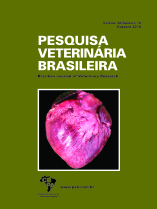 |
|
|
|
Year 2018 - Volume 38, Number 10
|

|
Biocompatibility of polyamide 12 intramedullary rod after humeral consolidation in white Plymouth Rock birds, 38(10):1909-1912
|
ABSTRACT.- Dias R.G., Magalhães G.M., Dias L.G.G.G., Rocha J.R., Dias F.G.G., Facin A.C. & Mattos Junior E. 2018. Biocompatibility of polyamide 12 intramedullary rod after humeral consolidation in white Plymouth Rock birds. [Biocompatibilidade de haste intramedular bloqueada de poliamida 12 após consolidação óssea umeral em aves Plymouth Rock branca.] Pesquisa Veterinária Brasileira 38(10):1909-1912. Faculdade de Ciências Agrárias e Veterinárias, Universidade Estadual Paulista, Campus Jaboticabal, Avenida Prof. Paulo Donato Castellane s/n, Jaboticabal, SP 14883-900, Brazil. E-mail: andreiacfacin@hotmail.com
Technological and tissue engineering have enabled available, biologically inert, and low cost materials to be considered as viable alternatives in the surgical treatment of long bone fractures in birds. The aim of this study was to microscopically analyse osteotomized humerus of birds following the insertion of solid laser-sintered polyamide 12 rods in order to detect foreign body reaction and, thus, verify the bioinert property of the material in the bone fracture environment. Polyamide 12 intramedullary rods were inserted into the osteotomized humerus of 10 birds (white Plymouth Rock) and blocked using 2mm diameter cortical screws of varying lengths. The birds were operated at 60 days of age and monitored post-operatively for three months. Animals were euthanized at 150 days old and samples of the operated humerus collected for immunohistochemistry, light and scanning electron microscopy analysis. Results show bone consolidation without rejection of the implant and absence of inflammatory cells. Vascular Endothelial Growth Factor (VEGF) was expressed in the endothelial cells of the blood vessels at the site of the newly formed bone surrounding the implant, indicative of local angiogenesis. There was no bone growth on the surface of the rod; however, the implant did not interfere with the circumjacent bone repair. Thus, the findings of this study corroborate with the literature in characterizing polyamide as a bioinert material and, under the studied conditions, it can be concluded that polyamide 12 intramedullary rod is biocompatible and provides adequate bone consolidation in humeral fractures with no signs of rejection. |
| |
|
|
| |
|
 |